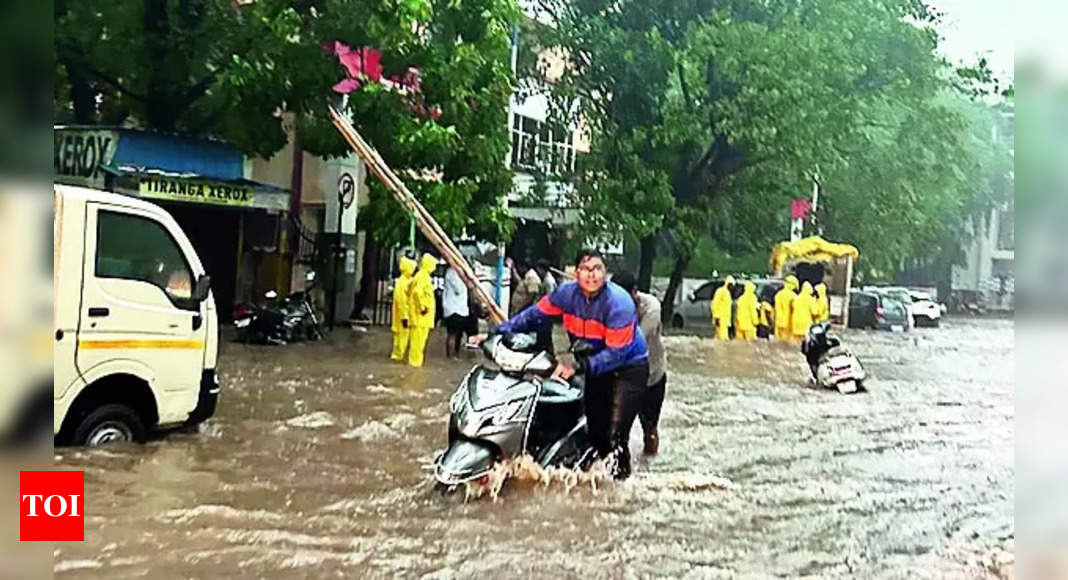
PUNE: The city recorded triple-digit rainfall in a matter of three hours on Saturday evening, with Shivajinagar (101.7mm) breaking its 33-year-old one-day rain record for June. The city had last received over 101mm rainfall in a period of 24 hours during the month over three decades ago — 123.3mm on June 8, 1991.
Lohegaon received 115.6mm of rain. Pune city (Shivajinagar) has already crossed its normal June rainfall quantum with the recent showers, even before monsoon has arrived over the city, an IMD official said.Normal rainfall in Shivajinagar in June is 183.9mm, while the city has so far received 193.8mm of rain.
Saturday’s rainstorm caused massive traffic snarls and severe waterlogging and left quite a few trees uprooted. Several low-lying areas were inundated with knee-deep waters, including the vicinity outside Pune railway station and the departure area of Lohegaon airport. Close to 20 flights since early afternoon hours were delayed at the Pune airport because of the heavy rain. An Air India Express flight from Bhubaneswar to Pune circled around the Pune airspace for a while before being diverted to Mumbai.
Medha Khole, head of the weather forecasting division at India Meteorological Department (IMD), Pune, told TOI, “By Saturday evening, monsoon had arrived at the extreme southern regions of Pune district, with the northernmost limit of monsoon passing through Harnai and Baramati.”
Lohegaon received 115.6mm of rain. Pune city (Shivajinagar) has already crossed its normal June rainfall quantum with the recent showers, even before monsoon has arrived over the city, an IMD official said.Normal rainfall in Shivajinagar in June is 183.9mm, while the city has so far received 193.8mm of rain.
Saturday’s rainstorm caused massive traffic snarls and severe waterlogging and left quite a few trees uprooted. Several low-lying areas were inundated with knee-deep waters, including the vicinity outside Pune railway station and the departure area of Lohegaon airport. Close to 20 flights since early afternoon hours were delayed at the Pune airport because of the heavy rain. An Air India Express flight from Bhubaneswar to Pune circled around the Pune airspace for a while before being diverted to Mumbai.
Medha Khole, head of the weather forecasting division at India Meteorological Department (IMD), Pune, told TOI, “By Saturday evening, monsoon had arrived at the extreme southern regions of Pune district, with the northernmost limit of monsoon passing through Harnai and Baramati.”
We also published the following articles recently
Is Pune prepared for monsoon?
Pre-monsoon rain highlights civic apathy in Pune’s drainage system and roads. PMC’s pre-monsoon works claim progress, but citizens and activists disagree.
Pre-monsoon rain highlights civic apathy in Pune’s drainage system and roads. PMC’s pre-monsoon works claim progress, but citizens and activists disagree.
Monsoon likely to arrive in Pune in next four days, says IMD forecast
IMD predicts thunderous weather with rainfall in Pune till June 7, leading to a reduction in daytime temperature. Monsoons expected in 3-4 days, with temperatures around 34-36C. Shivajinagar and Lohegaon observatories record above-normal temperatures. Humidity levels high, uncomfortable nights expected to change.
IMD predicts thunderous weather with rainfall in Pune till June 7, leading to a reduction in daytime temperature. Monsoons expected in 3-4 days, with temperatures around 34-36C. Shivajinagar and Lohegaon observatories record above-normal temperatures. Humidity levels high, uncomfortable nights expected to change.
111mm rain in 24 hours: Bengaluru breaks 133-year June record
Bengaluru experienced record-breaking thundershowers on Sunday, with 111.6mm of rain in 24 hours, surpassing the 133-year-old record. The rainfall data dates back to the 1850s, and C S Patil from IMD Bengaluru noted the previous record of 101.6mm in 1891.
Bengaluru experienced record-breaking thundershowers on Sunday, with 111.6mm of rain in 24 hours, surpassing the 133-year-old record. The rainfall data dates back to the 1850s, and C S Patil from IMD Bengaluru noted the previous record of 101.6mm in 1891.




